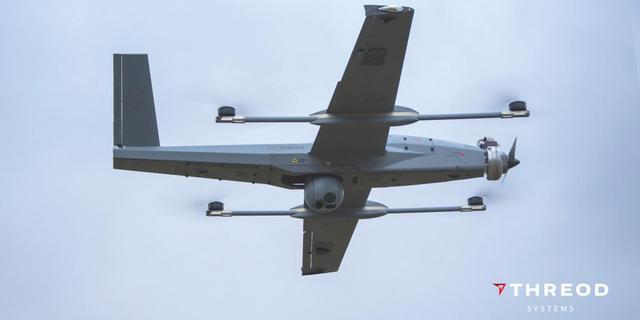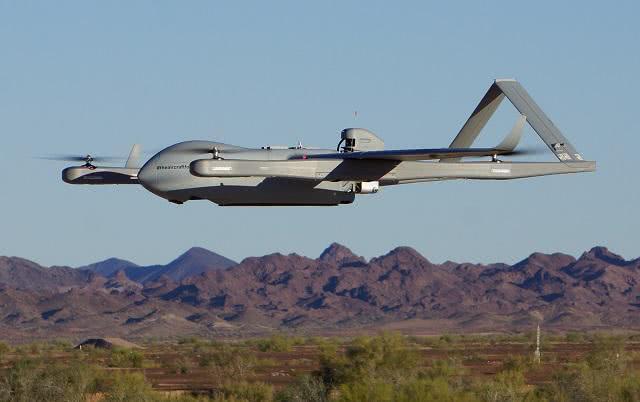Estonian Threod Systems has recently launched a military fixed-wing drone with vertical take-off and landing capability nimbus vtol. This vertical take-off and landing drone will be exhibited at the 2019 Abu Dhabi International Defense Exhibition and will compete with NATO military standards. Drone. According to Threod Systems, this vertical take-off and landing fixed-wing UAV can be used for taking off and landing from warships in addition to being used in urban street battles and other environments. It is very versatile.

Fixed-wing VTOL UAV developed by Threod Systems of Estonia
In terms of appearance, the aerodynamic layout of this fixed-wing vertical takeoff and landing drone launched by Threod Systems is almost the same as the current similar UAVs in the world. They are all four-rotor + propeller propellers. It adopts the mature layout of upper single wing and V-shaped vertical tail, and the photoelectric probe for reconnaissance and surveillance is placed under the belly of the aircraft, which can be said to be a very typical "public face" drone.

US Textron Corporation developed a fixed-wing VTOL UAV for the U.S. Army
In fact, not only the fixed-wing vertical take-off and landing UAVs of Threod Systems of Estonia, but the existing fixed-wing vertical take-off and landing UAVs in the world are almost the same. Unlike the various designs of fixed-wing fighters, the fixed-wing vertical take-off and landing Nine of the 10 UAVs all use a four-rotor + propeller propeller layout. The four rotors that provide vertical lift are located at the four corners of the center of gravity of the fuselage in a square layout. The rotor engine is connected to the main wing through a brace. The propeller, which provides forward power, is located at the nose or tail.

Ukrspecsystems, Ukraine launched the PD-1 fixed-wing vertical takeoff and landing drone
In addition, in terms of manufacturing cost, the fixed-wing vertical take-off and landing UAV with integral tilting of the power device, the tilting device structure is complex, and remote control is also a problem. The tilting actuator structure has a heavy weight, and the design, production and manufacturing links The cost is higher than the four-rotor + propeller-propelled composite UAV, so the military of various countries gives priority to low-cost composite fixed-wing vertical takeoff and landing UAVs when purchasing, which forces the arms dealers to develop four-rotor + propulsion Propeller layout of fixed-wing vertical takeoff and landing drones.

Nimbus VTOL is a versatile platform with a long endurance and large payload capacity. Its tilt-rotor vertical take-off on landing (VTOL) design allows it to autonomously take-off and land in an area as small as 4m x 4m, while carrying up to 1000g of payload for up to 80 minutes. Using large front-tilting high-speed servos the Nimbus VTOL can hover like a multi-rotor more steadily and take-off and land in very heavy wind. The servos will even tilt to a certain level to compensate for wind, which keeps the plane steadier during take-offs and landings. Max flying speed for Nimbus is 35m/s, though average speed is around 14m/s (stall speed around 11m/s). Of course, Mission Control is fully supported with Nimbus for easy, fully autonomous surveying with precise camera triggering based on mission parameters. Nimbus’ payload capabilities are very adaptable, thanks to its 1000g max capacity and large available mounting volume.
Specifications:
Version: Nimbus VTOL V2 EPO material
Wingspan: 1800mm
Length: 1300mm
Suggested Take-off Weight: 6kg
Suggested Payload: 800g
Total Weight: 3.36kg(no battery)
Max. Flying Height: 3500m
Max. Flying Speed: 35m/s
Average Speed: 15m/s to 16m/s
Stall Speed: 10m/s to 11m/s
Max Wind Resistance: ≤10.7m/s
Mapping Accuracy: Centimeter
Suggested Battery: 6S 12000mah Lipo Battery;
Your Purchase Includes:
PNP(WhiteVersion):
1x Nimbus VTOL V2 White Version
2x Tilt Servo
2x Tilt Motor
1x Tail Motor
1x Tail ESC
2x Tilt ESC
1x (pair) 13 inch Wooden Propellers
1x 17 inch Matt Propeller
1x Px4 Air Speedometer
1x ASSAN 8A UBEC
1x DK32 16-Channel Radio Controller
1x Pixhawk 2.1 Standard Set with Here GNSS







Contact: Fly Dragon Drone Tech.
Email: frank at dronefromchina.com
Add: NO. 9 Dayu Road PiDu distric, ChengDu 611730, China